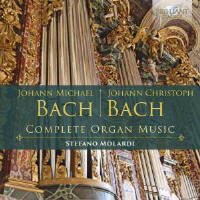Texte paru dans: / Appeared in: |
|
|
Outil de traduction ~ (Très approximatif) |
|
|
Reviewer: James
A. Altena Johann Christoph Bach (1642–1703) and his younger brother Johann Michael Bach (1648–1694) were both first cousins once removed to Johann Sebastian; a daughter of Johann Michael, Maria Barbara, would become Johann Sebastian’s first wife. The siblings were born and raised in Arnstadt; the elder originally became the organist for the castle chapel there in 1663 before moving on to Eisenach at the end of 1665 to assume jointly the positions of organist at the Georgenkirche and court organist and harpsichordist for the ducal court. Although he remained in both positions until his death (only 10 days after that of his wife), his years there were not particularly happy ones, being pockmarked by repeated quarrels with the town council and chronic illness. Although C. P. E. Bach would later praise him as being a “composer of depth,” such depth apparently did not extend to financial acumen, as he died heavily in debt. The life and career of Johann Michael was far less turbulent; described as “quiet, withdrawn, and artistically well versed,” he first succeeded his brother to the position in Arnstadt in 1665 and then in 1673 became organist and town clerk in the county seat of Gehren, holding those posts until his death. As composers, both were well respected craftsmen, though not noticeably original or even stylistically very distinct from one another. They composed mainly in the older homophonic tradition but showed some openness to the newer musical currents flowing northward from Italy, with Johann Christoph showing a decided predilection for use of chromaticism and the theme-and-variations form. Without exception, all of the works—except for a single prelude and fugue by Johann Christoph, all are chorales or sets of variations—have slow to very slow tempos and are of a serious mien.
This set is
a great idea, albeit marred by (for me, at any rate) one irritating flaw in
its layout. So far as I can ascertain, no one has previously undertaken to
record the complete surviving organ works of either of these two older
scions of the Bach clan. That alone makes this venture most welcome, and the
assured, stylish performances by Stefano Molardi—whose complete J. S. Bach
set was panned by both Jerry Dubins and myself in these pages (albeit lauded
in some other quarters), but whose complete set of Kuhnau’s organ works I
praised highly in 39:3—on the beautiful German Baroque organ of the
Cruciskirche in Erfurt, captured in fine recorded sound, sets the seal on a
hearty endorsement. The booklet provides notes on the works by Molardi,
specifications for the organ, and an artist bio. My one point of complaint
is that the works of Johann Michael could easily have been fit onto one CD
of just over 80 minutes length, and the works of Johann Christian on the
other two discs, but instead Brilliant has inconveniently intermixed sets of
works by the two composers on all three discs. But, at Brilliant’s
super-budget price, I won’t quibble too much over this; warmly recommended.
| |
|
Support us financially by purchasing this disc from eiher one of these suppliers. Un achat via l'un ou l'autre des fournisseurs proposés contribue à défrayer les coûts d'exploitation de ce site. |
|
|
|
|
|
Cliquez l'un ou l'autre
bouton pour découvrir bien d'autres critiques de CD |
|




